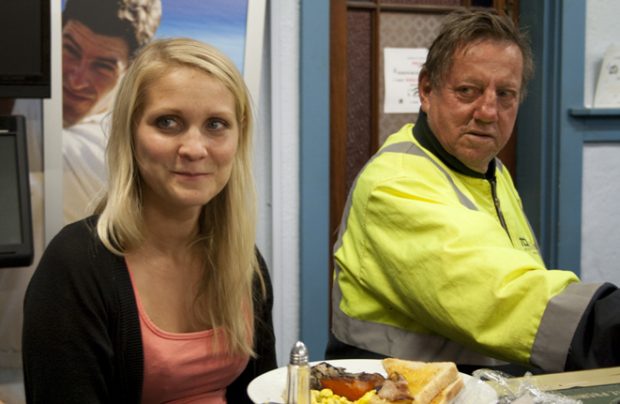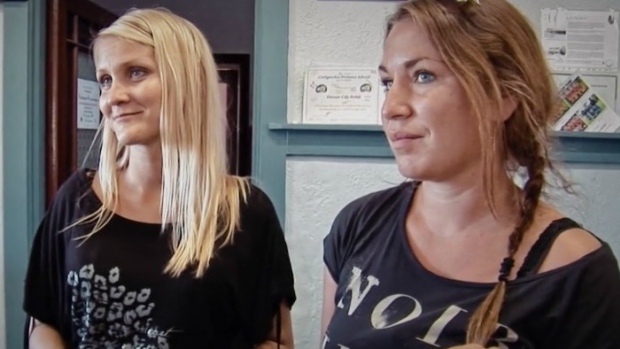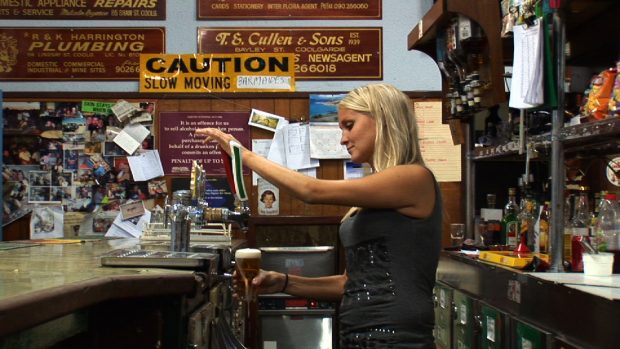Hotel Coolgardie shows what it really feels like to wake in fright.
Even though its director is male, Pete Gleeson’s Hotel Coolgardie is one of the few films which manages to offer a cinematic experience from the female perspective. Understanding the purpose of the fly-on-the-wall technique and the benefits of directorial restraint, this is a film which demands empathy from the viewer towards the two central women and the peripheral characters. It demonstrates how documentary filmmakers can, if they rein in their egos, reveal glimpses of human truths not usually exposed on camera. Of course, it helps that Gleeson’s subjects are pissed as newts and willingly reveal themselves.

Hotel Coolgardie 2016 – Image: Supplied
Wide establishing shots of an Australian red desert blistering in the sun’s heat are going to bring few other films to mind than Ted Kotcheff’s contested masterpiece Wake in Fright (1971). Gleeson is readily aware of his documentary’s cinematic counterpart and he uses it to his advantage—the plots are remarkably similar, depicting a fish out of water story in the Aussie outback: Lina and Steph are two Finnish backpackers looking to save some money so they can travel and see the rest of Australia.
They get put to work in the Denver City Hotel, a mining town pub a couple hundred kilometres out of Kalgoorlie. Gleeson builds the tension by giving us glimpses of what Lina and Steph are about to get into. The garrulous publican is telling the camera the girls don’t need experience if they look good, while a sign out front advertises ‘New girls tonite!’ One patron grins at the prospect of what he calls ‘Fresh meat’, and it doesn’t take long to realise that these two, like Wake in Fright’s John Grant, have no idea what they’re in for.
Where the film differs from its 1971 comparison is that where Kotcheff’s film was a horror movie exploiting the otherness of the outback, Gleeson’s is an outsider’s perspective on alcoholism and the way cultural masculinity breaks men and forces itself upon women.

Hotel Coolgardie 2016 – Image: Supplied
Before the film premiered at the Sydney film festival, the ABC reported that the film was receiving backlash for its one dimensional approach, portraying the town as ‘sleazy’ and not offering a fair portrait. These criticisms seem to miss the point of the film. With its observational approach, Gleeson wants audiences to be drawn in by the experience of his two subjects.
From the get go, Lina and Steph are out of sync with the ways of the hotel. In the crowded, raucous bar, their boss bellows orders at them when they’ve barely learned the names of the beers and where to find them. Anyone who has endured a rough first night at a new hospitality job can relate, especially when Gleeson makes sure to capture the pained expressions on the girls’ faces. It’s eventually Lina who embraces the culture more than her friend. Lina gets to know a few patrons, in particular Jamie, who tells his story of divorce and estrangement from his daughter in drunken slurs. When Steph takes a drive with Jamie, they sit in cringe-inducing silence and it’s clear she refuses to embrace the culture—she’s there to make money and get out.

Hotel Coolgardie 2016 – Image: Supplied
The girls are unlikely subjects for a documentary that explores a strange new place, but, similar to Wake in Fright, it’s a story of being dragged down by a place even as you’re clawing at the edges to stay out. Their reluctance makes for some unexpected humour, too. The way they awkwardly compose themselves, standing rigidly opposite to the patrons’ laconic slouches, as well as their Finnish English playing off against patrons’ slang (‘rough as bags’ … ‘balls in your purse’), is only painful if you can’t laugh at it.
Hotel Coolgardie is not an easy watch and it grasps a little wildly to find an ending—the perils of turning truth into narrative—but it is a fascinating one. It feels already like a timeless film, because it’s set in a place where men run from their demons and backpackers will always go to make a few quick dollars. There will always be stories to be told in places like Coolgardie.
Hotel Coolgardie is out Thursday 15 June.

